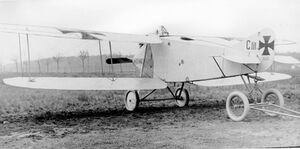Engineering:AEG C.III
| AEG C.III | |
|---|---|

| |
| Role | Reconnaissance[1] |
| Manufacturer | AEG[1] |
| Primary user | Luftstreitkräfte |
The AEG C.III was a two-seat biplane reconnaissance aircraft, a single prototype of which was built during World War I. The aircraft featured an unusual fuselage design that completely filled the gap between the upper and lower sets of wings, to provide the pilot with improved vision, and to allow the observer a wider field of fire for his 7.92 mm (.312 in) machine gun. The pilot sat to the rear of the observer, who was stationed over the upper wing. This design was not as successful as had been hoped, and the C.III was never entered into service. Despite being heavier than the C.II, its maximum speed increased to 158 km/h (98 mph).[1]
Specifications (AEG C.III)
Data from German Aircraft of the First World War[1]
General characteristics
- Crew: 2
- Length: 6.5 m (21 ft 4 in)
- Wingspan: 12 m (39 ft 4 in)
- Wing area: 36 m2 (390 sq ft)
- Empty weight: 687 kg (1,515 lb)
- Gross weight: 1,237 kg (2,727 lb)
- Powerplant: 1 × Benz Bz.III 6-cylinder, water-cooled, inline piston engine, 112 kW (150 hp)
Performance
- Maximum speed: 158 km/h (98 mph, 85 kn)
Armament
- Guns: 1 × 7.92 mm (.312 in) Parabellum MG14 or Bergmann MG 15nA machine gun with 550 rounds
- Bombs: 4 × 10 kg (20 lb) bombs
See also
Related lists
References
Further reading
- Kroschel, Günter; Stützer, Helmut: Die deutschen Militärflugzeuge 1910-18, Wilhelmshaven 1977
- Munson, Kenneth: Bomber 1914–19, Zürich 1968, Nr. 20
- Nowarra, Heinz: Die Entwicklung der Flugzeuge 1914-18, München 1959
- Sharpe, Michael: Doppeldecker, Dreifachdecker & Wasserflugzeuge, Gondrom, Bindlach 2001, ISBN:3-8112-1872-7
 |

